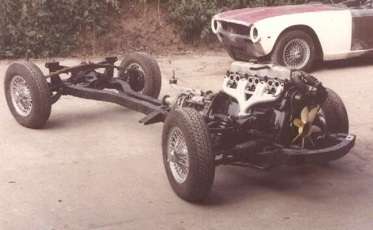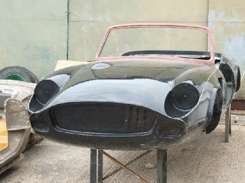Technical
Engine Options
With a range of standard Triumph power units from 1150cc four cylinder to 2000cc six cylinder there is plenty of variation in cars that have been built using Spitfire/GT6 engines. It is a relatively simple matter to perform an engine swap with these units without modifying engine mountings, chassis or bodywork. The 2500cc unit from the Triumph TR6 and saloons also fit just as easily. As per the original overheating can sometimes be a problem. A fully functioning cooling system will not cause any major bother on a standard engine. The first modification to make would be to fit simple ducting boards to funnel air from the grill to the radiator. Besides upgrading to an electric fan the only further option is to replace the radiators. Scouring the scrap yard will often produce larger, more effective units. One factor to consider is though the area of the standard unit is small it does have a deep core. Units that have been successfully used in conjunction with standard Triumph engines have been Peugeot 205 and Audi 100 (first shape) aluminium radiators.
Many owners have gone that one step further, fitting more unusual and extreme engines into their cars. Fiat/Lancia twin-cam units have been fitted with relative ease, as have standard Rover V8s. Two of the most extreme engine conversions to date however are a Supercharged 2500 Triumph Six and a 4.5l TVR V8.
At the other extreme there has been a very successful conversion of a Spitfire to electric power.
Any conversion that has been carried out in the past to Spitfires or GT6s can generally be applied to a Hurricane. Many Spitfire owners in the USA have performed engine transplants fitting Mazda rotary units, big V8s and all manner of eclectic units.
Gearbox/Transmission
The standard Triumph gearbox is the obvious choice for a Hurricane still using a Triumph engine, these are 4-speed units with an optional (and desirable) overdrive on third and top. The early units do not have synchromesh on first gear and are not the most robust gearbox available. Later units with the 'J' type overdrive unit are preferable. If a 2500cc engine is used then the TR6/Saloon gearbox will also fit the chassis with some minor modifications and is again more robust than the GT6 units.
What happens if you perform even more serious engine upgrades? A different gearbox altogether is definitely recommended. The five speed unit used with the Rover V8 is an option, with conversions available to fit the Ford Sierra Type 9 gearbox to this engine. There is also a conversion available from New Zealand to fit a Toyota five speed unit to Triumph six cylinder blocks. Beyond these options the only way to fit any other type is down to the type of engine, some head scratching and tape measuring as well as a suitable reserve of dirty cash.
The standard differential in good condition is perfectly capable of taking more power and torque without significant concern. These units should not however be expected to take the strain of a tuned V8 conversion for example. The owner of the TVR engined example has fitted a Sierra Cosworth Turbo LSD unit.
Suspension
Many specials and kit car builders such as Lotus have utilised the fully independent suspension from the Triumph Herald/Spitfire/GT6 range of cars. The front suspension consists of unequal length double wishbones and coilover dampers with an anti-roll bar. There is not much to be done to improve the standard arrangement besides careful setup of camber\castor and the re-bushing of the components. The anti-roll bar on some older models can also be upgraded to a thicker item from later Triumph models. And of course, aftermarket adjustable dampers from manufacturers such as Koni or Spax can also, with careful adjustment improve the quality of the handling. The only weak area in the front suspension is where the uprights fit into the trunnion. There is a tendency, once this bearing surface is no longer properly lubricated for the upright to shear at the shoulder where it fits into the trunnion itself. The way to avoiding this is to keep the trunnion regularly lubricated, more so than the factory manual's recommended intervals using EP90 gearbox oil, not grease. Another improvement is to drill a 3mm hole through the bottom horizontal wishbone pivot casing of the trunnion through into the inside of the threaded portion. Fit a grub screw to block the outermost hole you have created. The two bearing surfaces of the trunnion are now linked by a small duct and as you pump lubricant into it through the nipple it will penetrate both of them.
The rear Triumph suspension is also fully independent but of a controversial design. It consists of a swing axle design with a transverse leaf spring. As the wheels and shafts pivot at the differential the path they travel under movement is in an arc. This means that, in simple terms, when the suspension is fully extended the car rests on the outside edge of it's tyres. Under full compression the tyres rest on their inside edges. During hard cornering if this extreme transition can occur (caused by braking or backing off the throttle quickly for example) the rear tyres can lose traction causing massive oversteer. Triumph made modification to lessen this effect by modifying the rear suspension to include rotoflex joints. These are basically huge rubber doughnuts that separate the hub from the driveshaft and allow a certain amount of flex. Although these do reduce the oversteer effects and improve the handling, the rubber doughnuts do wear out. Replace them with the best you can get, OE if possible. There are some very poor pattern parts which will wear out much more quickly causing even more expense. Another component which can degrade is the rear spring. Corrosion stops the leafs from sliding over each other, effectively stiffening the spring rate and causing a harsh ride. Several modifications have been made to the rear suspension of some Hurricanes to differing degrees. Using the rotoflex rear end a double wishbone\coilover setup has been engineered. The conversion to a completely different differential opens up the opportunity to engineer any setup desired.
Brakes
The standard Spitfire/GT6 brake set up is a perfectly adequate system when the fact the Hurricane is a lighter car than the donor is taken into consideration. Improvements can be made however such as cross drilling the front discs and fitting better performing pads at the front, shoes at the rear. If the car is being used in motorsport or a track environment then fade may start to become an issue. The most popular conversion is to fit Ford Capri 2.8i ventilated discs to avoid the brake fade issue. The calipers need widening to accommodate the wider discs. This can be done by a spacing plate carefully engineered to fit in between the two halves of the caliper. These were once commercially available but locating a current supplier may prove difficult. To improve stopping power it is possible to replace the single piston front calipers with dual piston units that were fitted to the Austin Princess. These are a fairly straight forward conversion, with spacing plates available to make them fit Capri vented discs.
Bodywork
When the motoring press first saw the Vincent Hurricane they were impressed by the quality and design of the body's construction. Using fibre glass with bonded in 1" marine ply, square section steel tubing and two-pack foam the body tub is actually stronger and lighter than the steel ones produced by Triumph. All of the edges of the components such as the wheel arches have returned edges. The bonnet and tub are fitted with inner arches to avoid stones thrown from the tyres causing crazing in the surface gel coat. One of the prime objectives when the body was designed was that it had to use as much of the donor car's equipment as possible. The doors were made to accept window glass, winding mechanism, locks and latches. They even take the standard Triumph trim panels. The doors were re-enforced with tubular steel to protect the occupants from side intrusion during an accident. As well as tubular steel in the doors the sills were injected with expanding foam which when hardened not only stiffened the tub but provided additional protection. The standard wet weather kit fits directly onto the car along with it's windscreen and wiper/washer units. In fact, the only non-Triumph components the builder needed to source were the rear lights and bonnet catch system. As the Hurricane did away with the finger trapping chrome Michelotti catches the builder could either fit leather straps in their place or a central catch, often from the Renault 5.
Besides the fact that a glass fibre body doesn't rust it also is easier to modify. Adding air scoops for bigger engines, extended wheel arches and other accoutrements is much simpler. Browse through the gallery and often as not someone will have personalised their car somewhere along the line.




